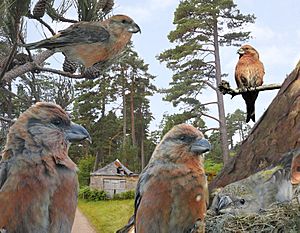Scottish crossbill facts for kids
Quick facts for kids Scottish crossbill |
|
|---|---|
 |
|
| Conservation status | |
| Scientific classification | |
| Genus: |
Loxia
|
| Species: |
scotica
|
The Scottish crossbill (Loxia scotica) is a small passerine bird that belongs to the finch family. It lives only in the Caledonian Forests of Scotland. This makes it the only land animal with a backbone that is found only in the United Kingdom. Scientists confirmed the Scottish crossbill as its own unique species in August 2006. They found it has a very special bird song that no other bird has.
The name Loxia comes from an Ancient Greek word loxos, which means "crosswise." The word scotica is Latin for "Scottish." In Scottish Gaelic, the name for a crossbill is Cam-ghob. This name literally means "squinty beaked," which describes its unique bill.
Contents
About the Scottish Crossbill
The Scottish crossbill is known for its unusual beak. Its upper and lower parts cross over at the tips. This special bill helps the bird get seeds out of conifer cones. It's like a special tool just for eating pine and larch seeds!
Adult male crossbills are usually red or orange. Females are often green or yellow. But there can be many different colors. It is very hard to tell the Scottish crossbill apart from other types of crossbills, like the red crossbill or parrot crossbill. Their feathers look almost the same.
The best way to identify a Scottish crossbill is by its metallic jip call. Even then, experts often need to record the call and look at it on a special graph called a sonogram to be sure.
Its Unique Call
Scientists have studied the calls of Scottish crossbills for a long time. They found that these birds have a distinct "Scottish accent" in their calls. This special call helps them find and choose mates of their own species. It's important because they look so much like other crossbills.
Research has shown that Scottish crossbills, red crossbills, and parrot crossbills do not usually breed with each other. This means they are truly different species. Their unique calls and bill sizes help them stay separate.
Bill Structure and Family Life
The British Ornithologists Union first said the Scottish crossbill was a separate species in 1980. However, some scientists wanted more proof. They thought it might just be a type of red crossbill or parrot crossbill. Both of these birds also live in the Caledonian Forest.
The RSPB (Royal Society for the Protection of Birds) did a lot of research. They found that Scottish crossbills have very different flight and excitement calls. These calls are unique from other crossbills.
One important part of the RSPB's study was to see if crossbills mate with birds that have similar bill sizes and calls. They also wanted to know if young Scottish crossbills get their bill sizes from their parents. The results showed that almost all pairs of different crossbills matched closely in bill size and calls. This proved that they act like distinct species.
Where They Live and How They Live
The Scottish crossbill lives and breeds in the native Scots pine (Pinus sylvestris) forests of the Scottish Highlands. But you might also find them in forestry plantations. These plantations often have non-native conifer trees like Larch (Larix decidua and L. kaempferi) and Lodgepole pine (Pinus contorta).
This bird does not migrate. It stays in Scotland all year round. Outside of the breeding season, Scottish crossbills often form flocks. Sometimes, these flocks include other types of crossbills too.
The population of Scottish crossbills is thought to be around 20,000 birds. They build their nests in pine or other conifer trees. Females usually lay 2 to 5 eggs.
Conservation Efforts
The first full survey of Scottish crossbills happened in 2008. Even though we don't have a lot of information on how their numbers are changing, the magazine British Birds has put the Scottish crossbill on its Amber list. This means it's a species of conservation concern because it's found only in Scotland.
A report in 2017 by the British Trust for Ornithology said that the Scottish crossbill is at high risk of disappearing. There are breeding populations of these birds in special places like Corrimony Nature Reserve and Loch Garten Nature Reserve. Loch Garten is one of the most protected nature sites in the United Kingdom.
See also
 In Spanish: Piquituerto escocés para niños
In Spanish: Piquituerto escocés para niños


